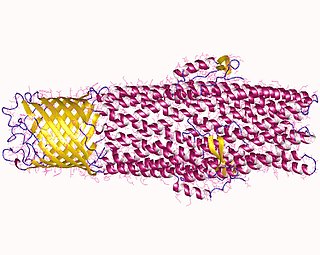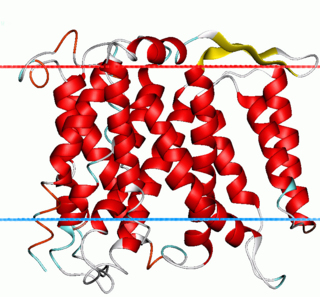Related Research Articles

Cotransporters are a subcategory of membrane transport proteins (transporters) that couple the favorable movement of one molecule with its concentration gradient and unfavorable movement of another molecule against its concentration gradient. They enable cotransport and include antiporters and symporters. In general, cotransporters consist of two out of the three classes of integral membrane proteins known as transporters that move molecules and ions across biomembranes. Uniporters are also transporters but move only one type of molecule down its concentration gradient and are not classified as cotransporters.
Drug metabolism is the metabolic breakdown of drugs by living organisms, usually through specialized enzymatic systems. More generally, xenobiotic metabolism is the set of metabolic pathways that modify the chemical structure of xenobiotics, which are compounds foreign to an organism's normal biochemistry, such as any drug or poison. These pathways are a form of biotransformation present in all major groups of organisms and are considered to be of ancient origin. These reactions often act to detoxify poisonous compounds. The study of drug metabolism is called pharmacokinetics.

P-glycoprotein 1 also known as multidrug resistance protein 1 (MDR1) or ATP-binding cassette sub-family B member 1 (ABCB1) or cluster of differentiation 243 (CD243) is an important protein of the cell membrane that pumps many foreign substances out of cells. More formally, it is an ATP-dependent efflux pump with broad substrate specificity. It exists in animals, fungi, and bacteria, and it likely evolved as a defense mechanism against harmful substances.

All microorganisms, with a few exceptions, have highly conserved DNA sequences in their genome that are transcribed and translated to efflux pumps. Efflux pumps are capable of moving a variety of different toxic compounds out of cells, such as antibiotics, heavy metals, organic pollutants, plant-produced compounds, quorum sensing signals, bacterial metabolites and neurotransmitters via active efflux, which is vital part for xenobiotic metabolism. This active efflux mechanism is responsible for various types of resistance to bacterial pathogens within bacterial species - the most concerning being antibiotic resistance because microorganisms can have adapted efflux pumps to divert toxins out of the cytoplasm and into extracellular media.
Geoffrey Chang is a professor at the University of California, San Diego's Skaggs School of Pharmacy and Pharmaceutical Sciences and Department of Pharmacology, School of Medicine. His laboratory focuses on the structural biology of integral membrane proteins, particularly exploring X-ray crystallography techniques for solving the tertiary structures of membrane proteins that are notoriously resistant to crystallization. The laboratory has specialized in structures of multidrug resistance transporter proteins in bacteria. In 2001, while a faculty member of The Scripps Research Institute, Chang was awarded a Beckman Young Investigators Award, designed to support researchers early in their academic careers, for his work on the structural biology of multidrug resistance. Chang announced a move from Scripps to neighboring UC San Diego in 2012.

ATP-binding cassette sub-family C member 4 (ABCC4), also known as the multidrug resistance-associated protein 4 (MRP4) or multi-specific organic anion transporter B (MOAT-B), is a protein that in humans is encoded by the ABCC4 gene.

ATP-binding cassette super-family G member 2 is a protein that in humans is encoded by the ABCG2 gene. ABCG2 has also been designated as CDw338.

Multidrug and toxin extrusion protein 1 (MATE1), also known as solute carrier family 47 member 1, is a protein that in humans is encoded by the SLC47A1 gene. SLC47A1 belongs to the MATE family of transporters that are found in bacteria, archaea and eukaryotes.

Multidrug and toxin extrusion protein 2 is a protein which in humans is encoded by the SLC47A2 gene.

Y+L amino acid transporter 2, also known as cationic amino acid transporter, y+ system, is a protein that in humans is encoded by the SLC7A6 gene.
Small multidrug resistance protein is a family of integral membrane proteins that confer drug resistance to a wide range of toxic compounds by removing them for the cells. The efflux is coupled to an influx of protons. An example is Escherichia coli mvrC P23895 which prevents the incorporation of methyl viologen into cells and is involved in ethidium bromide efflux.

Neisseria gonorrhoeae, the bacterium that causes the sexually transmitted infection gonorrhea, has developed antibiotic resistance to many antibiotics. The bacteria was first identified in 1879.
The multidrug/oligosaccharidyl-lipid/polysaccharide (MOP) flippase superfamily is a group of integral membrane protein families. The MOP flippase superfamily includes twelve distantly related families, six for which functional data are available:
- One ubiquitous family (MATE) specific for drugs - (TC# 2.A.66.1) The Multi Antimicrobial Extrusion (MATE) Family
- One (PST) specific for polysaccharides and/or their lipid-linked precursors in prokaryotes - (TC# 2.A.66.2) The Polysaccharide Transport (PST) Family
- One (OLF) specific for lipid-linked oligosaccharide precursors of glycoproteins in eukaryotes - (TC# 2.A.66.3) The Oligosaccharidyl-lipid Flippase (OLF) Family
- One (MVF) lipid-peptidoglycan precursor flippase involved in cell wall biosynthesis - (TC# 2.A.66.4) The Mouse Virulence Factor (MVF) Family
- One (AgnG) which includes a single functionally characterized member that extrudes the antibiotic, Agrocin 84 - (TC# 2.A.66.5) The Agrocin 84 Antibiotic Exporter (AgnG) Family
- And finally, one (Ank) that shuttles inorganic pyrophosphate (PPi) - (TC# 2.A.66.9) The Progressive Ankylosis (Ank) Family
The ion transporter (IT) superfamily is a superfamily of secondary carriers that transport charged substrates.

Na+/H+ antiporter A (NhaA) family (TC# 2.A.33) contains a number of bacterial sodium-proton antiporter (SPAP) proteins. These are integral membrane proteins that catalyse the exchange of H+ for Na+ in a manner that is highly pH dependent. Homologues have been sequenced from a number of bacteria and archaea. Prokaryotes possess multiple paralogues. A representative list of the proteins that belong to the NhaA family can be found in the Transporter Classification Database.
The NhaD family belongs to the Ion Transporter (IT) Superfamily. A representative list of proteins belonging to the NhaD family can be found in the Transporter Classification Database.
The Monovalent Cation:Proton Antiporter-2 (CPA2) Family is a moderately large family of transporters belonging to the CPA superfamily. Members of the CPA2 family have been found in bacteria, archaea and eukaryotes. The proteins of the CPA2 family consist of between 333 and 900 amino acyl residues and exhibit 10-14 transmembrane α-helical spanners (TMSs).
The Monovalent Cation (K+ or Na+):Proton Antiporter-3 (CPA3) Family (TC# 2.A.63) is a member of the Na+ transporting Mrp superfamily. The CPA3 family consists of bacterial multicomponent K+:H+ and Na+:H+ antiporters. The best characterized systems are the PhaABCDEFG system of Sinorhizobium meliloti (TC# 2.A.63.1.1) that functions in pH adaptation and as a K+ efflux system, and the MnhABCDEFG system of Staphylococcus aureus (TC# 2.A.63.1.3) that functions as a Na+ efflux Na+:H+ antiporter.
Multidrug resistance pumps also known Multidrug efflux pumps are a type of efflux pump and P-glycoprotein. MDR pumps in the cell membrane extrudes many foreign substances out of the cells and some pumps can have a broad specificity. MDR pumps exist in animals, fungi, and bacteria and likely evolved as a defense mechanism against harmful substances. There are seven families of MDRs and are grouped by homology, energy source, and overall structure.

Resistance-nodulation-division (RND) family transporters are a category of bacterial efflux pumps, especially identified in Gram-negative bacteria and located in the cytoplasmic membrane, that actively transport substrates. The RND superfamily includes seven families: the heavy metal efflux (HME), the hydrophobe/amphiphile efflux-1, the nodulation factor exporter family (NFE), the SecDF protein-secretion accessory protein family, the hydrophobe/amphiphile efflux-2 family, the eukaryotic sterol homeostasis family, and the hydrophobe/amphiphile efflux-3 family. These RND systems are involved in maintaining homeostasis of the cell, removal of toxic compounds, and export of virulence determinants. They have a broad substrate spectrum and can lead to the diminished activity of unrelated drug classes if over-expressed. The first reports of drug resistant bacterial infections were reported in the 1940s after the first mass production of antibiotics. Most of the RND superfamily transport systems are made of large polypeptide chains. RND proteins exist primarily in gram-negative bacteria but can also be found in gram-positive bacteria, archaea, and eukaryotes.
References
- 1 2 Brown MH, Paulsen IT, Skurray RA (January 1999). "The multidrug efflux protein NorM is a prototype of a new family of transporters". Mol. Microbiol. 31 (1): 394–5. doi:10.1046/j.1365-2958.1999.01162.x. PMID 9987140. S2CID 39261040.
- 1 2 Kuroda T, Tsuchiya T (December 2008). "Multidrug efflux transporters in the MATE family". Biochim. Biophys. Acta. 1794 (5): 763–8. doi:10.1016/j.bbapap.2008.11.012. PMID 19100867.
- 1 2 Omote H; et al. (2006). "The MATE proteins as fundamental transporters of metabolic and xenobiotic organic cations". Trends in Pharmacological Sciences. 27 (11): 587–93. doi:10.1016/j.tips.2006.09.001. PMID 16996621.
- ↑ Hvorup RN, Winnen B, Chang AB, Jiang Y, Zhou XF, Saier MH (March 2003). "The multidrug/oligosaccharidyl-lipid/polysaccharide (MOP) exporter superfamily". Eur. J. Biochem. 270 (5): 799–813. doi:10.1046/j.1432-1033.2003.03418.x. PMID 12603313.
- ↑ He X, Szewczyk P, Karykin A, Hong WX, Zhang Q, Chang G (2010). "Structure of a Cation-bound Multidrug and Toxic Compound Extrusion Transporter". Nature. 467 (7318): 991–994. Bibcode:2010Natur.467..991H. doi:10.1038/nature09408. PMC 3152480 . PMID 20861838.
- ↑ Morita Y, Kodama K, Shiota S, Mine T, Kataoka A, Mizushima T, Tsuchiya T (July 1998). "NorM, a Putative Multidrug Efflux Protein, of Vibrio parahaemolyticus and Its Homolog in Escherichia coli". Antimicrob. Agents Chemother. 42 (7): 1778–82. doi:10.1128/AAC.42.7.1778. PMC 105682 . PMID 9661020.
- ↑ Morita Y, Kataoka A, Shiota S, Mizushima T, Tsuchiya T (December 2000). "NorM of Vibrio parahaemolyticus Is an Na+-Driven Multidrug Efflux Pump". J. Bacteriol. 182 (23): 6694–7. doi:10.1128/JB.182.23.6694-6697.2000. PMC 111412 . PMID 11073914.
- ↑ van Veen HW (2010). "Structural biology: Last of the multidrug transporters". Nature. 467 (7318): 926–7. Bibcode:2010Natur.467..926V. doi:10.1038/467926a. PMID 20962836. S2CID 4338964.
| This membrane protein–related article is a stub. You can help Wikipedia by expanding it. |